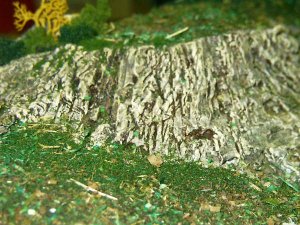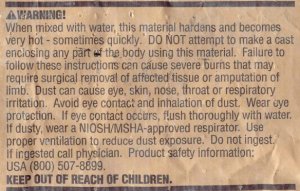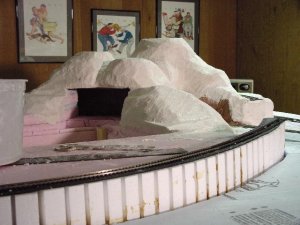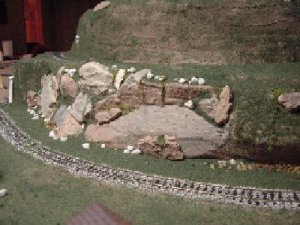Having jumped over the hurdle that was my fear of beginning my scenery, I'm now headlong into cuts and valleys on my door based N layout.  Since the quantities needed are small, I've gone with the WS plaster cloth, which is great stuff. Easy and fun to use.
Since the quantities needed are small, I've gone with the WS plaster cloth, which is great stuff. Easy and fun to use.
However--
Probably thanks to not doing it quite right, I've got areas where the 'mesh' is visible, ie there is plaster missing. This is because I didn't use a brush to spread it out and I'm also not overlapping the product as much as I likely should. I've also got some gaps here and there where I need to mate tunnel portals and things to the mountains. I made some feeble attempts at doing this with the lightweight Hydrocal, but I find that it dries far too quickly for me to manage it. My first batch actually was drying on the brush. I've since added water to slow it down but it still isn't easily used to patch these areas. Therefore:
I've since added water to slow it down but it still isn't easily used to patch these areas. Therefore:
1) How to cover areas where I'm too thin. Another layer of plaster cloth? Better way to use the LW Hydrocal? Or do I go with a different product?
2) How to fill the gaps. Get the slower acting plaster from WS? Kinda hate to buy all that product if I don't need more than a little.
3) Is drywall mud a suitable product for any of this? Have some in stock.
4) My layout base is foam board. Would it be wise to cover all the foam with some sort of plaster product to add texture?
5) I read somewhere today that Hydrocal may not accept paint easily?
BTW, the Hydrocal hasn't been a total bust...I'm having a jolly time casting rock faces using aluminum foil molds. Works surprisingly well. :thumb:
However--
Probably thanks to not doing it quite right, I've got areas where the 'mesh' is visible, ie there is plaster missing. This is because I didn't use a brush to spread it out and I'm also not overlapping the product as much as I likely should. I've also got some gaps here and there where I need to mate tunnel portals and things to the mountains. I made some feeble attempts at doing this with the lightweight Hydrocal, but I find that it dries far too quickly for me to manage it. My first batch actually was drying on the brush.
1) How to cover areas where I'm too thin. Another layer of plaster cloth? Better way to use the LW Hydrocal? Or do I go with a different product?
2) How to fill the gaps. Get the slower acting plaster from WS? Kinda hate to buy all that product if I don't need more than a little.
3) Is drywall mud a suitable product for any of this? Have some in stock.
4) My layout base is foam board. Would it be wise to cover all the foam with some sort of plaster product to add texture?
5) I read somewhere today that Hydrocal may not accept paint easily?
BTW, the Hydrocal hasn't been a total bust...I'm having a jolly time casting rock faces using aluminum foil molds. Works surprisingly well. :thumb:






